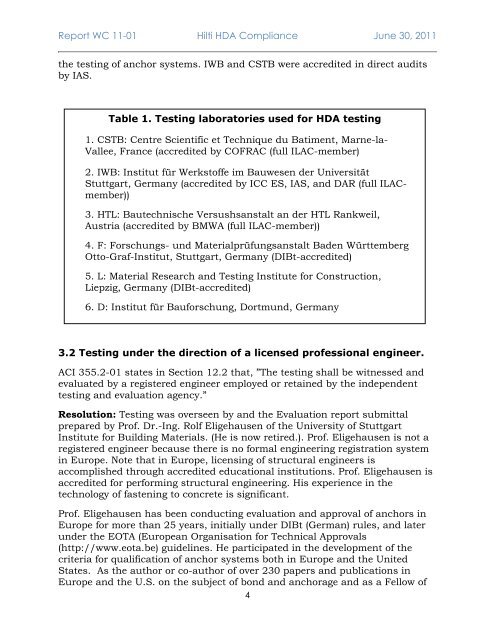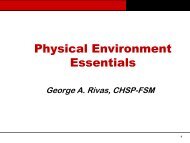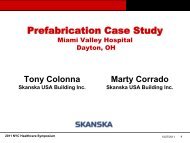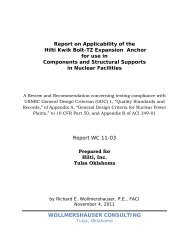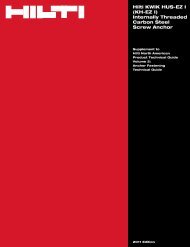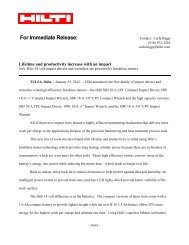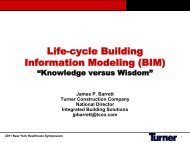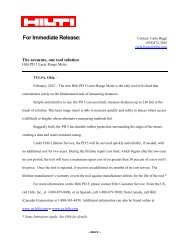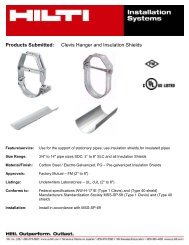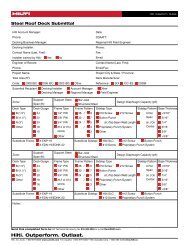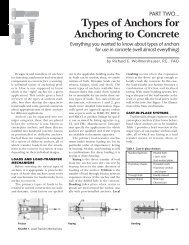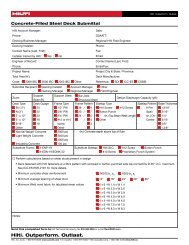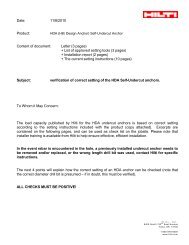HDA Nuclear Report on Testing and Evaluation - Hilti Egypt
HDA Nuclear Report on Testing and Evaluation - Hilti Egypt
HDA Nuclear Report on Testing and Evaluation - Hilti Egypt
You also want an ePaper? Increase the reach of your titles
YUMPU automatically turns print PDFs into web optimized ePapers that Google loves.
<str<strong>on</strong>g>Report</str<strong>on</strong>g> WC 11-01 <strong>Hilti</strong> <str<strong>on</strong>g>HDA</str<strong>on</strong>g> Compliance June 30, 2011<br />
the testing of anchor systems. IWB <strong>and</strong> CSTB were accredited in direct audits<br />
by IAS.<br />
Table 1. <strong>Testing</strong> laboratories used for <str<strong>on</strong>g>HDA</str<strong>on</strong>g> testing<br />
1. CSTB: Centre Scientific et Technique du Batiment, Marne-la-<br />
Vallee, France (accredited by COFRAC (full ILAC-member)<br />
2. IWB: Institut für Werkstoffe im Bauwesen der Universität<br />
Stuttgart, Germany (accredited by ICC ES, IAS, <strong>and</strong> DAR (full ILACmember))<br />
3. HTL: Bautechnische Versushsanstalt an der HTL Rankweil,<br />
Austria (accredited by BMWA (full ILAC-member))<br />
4. F: Forschungs- und Materialprüfungsanstalt Baden Württemberg<br />
Otto-Graf-Institut, Stuttgart, Germany (DIBt-accredited)<br />
5. L: Material Research <strong>and</strong> <strong>Testing</strong> Institute for C<strong>on</strong>structi<strong>on</strong>,<br />
Liepzig, Germany (DIBt-accredited)<br />
6. D: Institut für Bauforschung, Dortmund, Germany<br />
3.2 <strong>Testing</strong> under the directi<strong>on</strong> of a licensed professi<strong>on</strong>al engineer.<br />
ACI 355.2-01 states in Secti<strong>on</strong> 12.2 that, ”The testing shall be witnessed <strong>and</strong><br />
evaluated by a registered engineer employed or retained by the independent<br />
testing <strong>and</strong> evaluati<strong>on</strong> agency.”<br />
Resoluti<strong>on</strong>: <strong>Testing</strong> was overseen by <strong>and</strong> the Evaluati<strong>on</strong> report submittal<br />
prepared by Prof. Dr.-Ing. Rolf Eligehausen of the University of Stuttgart<br />
Institute for Building Materials. (He is now retired.). Prof. Eligehausen is not a<br />
registered engineer because there is no formal engineering registrati<strong>on</strong> system<br />
in Europe. Note that in Europe, licensing of structural engineers is<br />
accomplished through accredited educati<strong>on</strong>al instituti<strong>on</strong>s. Prof. Eligehausen is<br />
accredited for performing structural engineering. His experience in the<br />
technology of fastening to c<strong>on</strong>crete is significant.<br />
Prof. Eligehausen has been c<strong>on</strong>ducting evaluati<strong>on</strong> <strong>and</strong> approval of anchors in<br />
Europe for more than 25 years, initially under DIBt (German) rules, <strong>and</strong> later<br />
under the EOTA (European Organisati<strong>on</strong> for Technical Approvals<br />
(http://www.eota.be) guidelines. He participated in the development of the<br />
criteria for qualificati<strong>on</strong> of anchor systems both in Europe <strong>and</strong> the United<br />
States. As the author or co-author of over 230 papers <strong>and</strong> publicati<strong>on</strong>s in<br />
Europe <strong>and</strong> the U.S. <strong>on</strong> the subject of b<strong>on</strong>d <strong>and</strong> anchorage <strong>and</strong> as a Fellow of<br />
4


